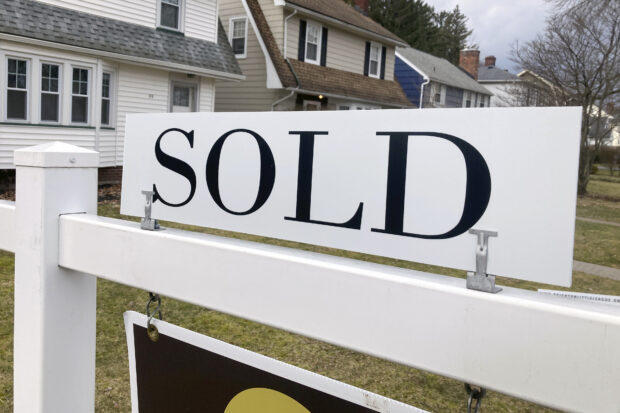
A sold sign hangs in front of a Brighton, New York house on Tuesday, Feb 21, 2023. The average rate on a 30-year mortgage rose to 6.66 percent from 6.62 percent last week, mortgage buyer Freddie Mac said Thursday, Jan. 11, 2024. (AP Photo/Ted Shaffrey, File)
LOS ANGELES — The average long-term U.S. mortgage rate rose for the second time in as many weeks, climbing to its highest level in four weeks.
The average rate on a 30-year mortgage rose to 6.66 percent from 6.62 percent last week, mortgage buyer Freddie Mac said Thursday. A year ago, the rate averaged 6.33 percent.
Borrowing costs on 15-year fixed-rate mortgages, popular with homeowners refinancing their home loans, eased this week, bringing the average rate to 5.87 percent from 5.89 percent last week. A year ago, it averaged 5.52 percent, Freddie Mac said.
The latest increase in the average rate on a 30-year home loan follows a nine-week string of declines at the end of last year that lowered the average rate after it surged in late October to 7.79 percent, the highest level since late 2000.
READ: Sales of new US homes slowed in Oct
Still, the average rate on a 30-year home loan remains sharply higher than just two years ago, when it was 3.45 percent. That large gap between rates now and then has helped limit the number of previously occupied homes on the market by discouraging homeowners who locked in rock-bottom rates from selling.
Homebuyers’ purchasing power
It has also crushed homebuyers’ purchasing power at a time when home prices have kept rising even as sales of previously occupied U.S. homes slumped more than 19 percent through the first 11 months of last year.
“Mortgage rates have not moved materially over the last three weeks and remain in the mid-6 percent range, which has marginally increased homebuyer demand,” said Sam Khater, Freddie Mac’s chief economist. “Even this slight uptick in demand, combined with inventory that remains tight, continues to cause prices to rise faster than incomes, meaning affordability remains a major headwind for buyers.”
READ: US consumer confidence rebounds, house prices maintain upward trend
The overall decline in mortgage rates since late October has loosely followed a pullback in the 10-year Treasury yield, which lenders use as a guide to pricing loans. The yield, which in mid October surged to its highest level since 2007, has largely fallen on hopes that inflation has cooled enough for the Federal Reserve, which has opted to not move rates at its last three meetings, to shift to cutting interest rates this year.
Housing economists expect that the average rate on a 30-year mortgage will decline further this year, though forecasts generally see it moving no lower than 6 percent.

